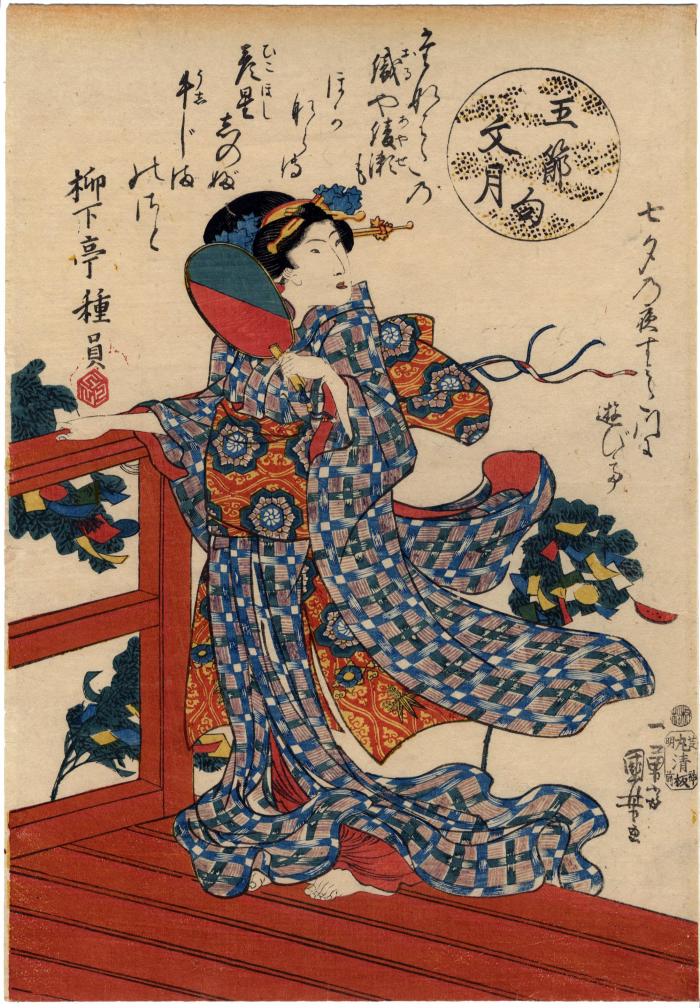Utagawa Kuniyoshi (歌川国芳) (artist 11/15/1797 – 03/05/1861)
Tanabata (七夕) from the series of the Five Festivals (Go sekku - 五節句), the Seventh Month (文月)
ca 1843 – 1846
10 in x 14.25 in (Overall dimensions) Japanese woodblock print
Signed: Ichiyūsai Kuniyoshi ga
一勇斎国芳画
Publisher: Maruya Seijirō
(Marks 299 - seal 27-010)
Censor's seal: Muramatsu
Text by: Ryūkatei Tanekazu (柳下亭種員)
Lyon Collection - another copy of this print
Kumon Museum of Children's Ukiyo-e - with explanatory notes There is another Kuniyoshi print from ca. 1836 of this same theme and general layout. That one, however, shows a woman accompanied by a child. Whereas, we thought that this print in the Lyon Collection showed a woman on a bridge, it turns out, according to Iwakiri and Newland, in their catalogue Kuniyoshi: Japanese master of imagined worlds on page 92, that this is most likely a viewing platform.
They wrote of that print: "Mulberry leaf, brush and watermelon shapes decorated bamboo grass (seen in the background...). A woman and child stand on a rooftop look-out platform; judging by this woman's fluttering robes, it appears to be very windy."
****
The quote above the bijin is by Ryūkatei Tanekazu (柳下亭種員: 1807-58). His name is shown along the left side with his seal.
****
Tanabata, the Weaver or Star Festival
Celebrated for ages as a lunisolar holiday held on the traditional 7th day of the 7th month. According to the Chinese tradition, adopted by the Japanese, the Cowherd (kengyū 牽牛), i.e., Altair in the Aquila constellation, the Eagle, travels across the Milky Way, to meet up with the Weaver Maiden (shokujo 織女, Vega in the Lyra constellation) for only one day a year. The name of the festival comes from Tanabata-hime (棚機姫} or Princess Tanabata who weaves fabrics for the gods.
"The legend of tanabata was already widespread at the time of the Man'yōshū -[compiled by poems composed from the 4th through the middle of the 8th century] - which account for more than 100 poems on this theme."
A progenitor of the Tanabata Festival was the kikōden or 乞巧奠 or the Festival to Pray for Skills. This, too, originated in China, but by the Heian period it had become a seasonal celebration adopted by the court nobility. Poetry competitions were common at this time. By the time of the Edo period this festival was included in the Go sekku - 五節句 and was extended to the population in general.
The Tanabata Festival came to be viewed as a prelude to the Bon (盆) Festival that honors the spirits of one's deceased ancestors. It also has a link to the origin of sūmo as a quasi-religious ceremony.
Source and quote from: Dictionnaire historique du Japon, 1993, page 48.
****
"Tanabata [七夕] originated in the ancient traditional belief that the Star Weaver which separated by Ama-no-gawa (Heavenly River) or Milky Way from her lover, the Altair, all the year round, meet once a year round meet once a year on the evening of July 7. Also it tells that Japanese women worshiped the Weaver as weaving was one of their most important household tasks in early days. Thus it is primarily a girls' festival. But since it became a national event in the seventh year of Tenpyo Shoho or 755, it has been most elaborately observed by all the people through 10 long centuries.
The romantic belief that the Weaver and the Altair met only once a year appealed to the imagination or the sentiment of young girls. For the success of their own love they eagerly prayed at the festival. Also they prayed that the evening would be fair in weather, as they thought that, if it rained, the Milky Way would be flooded and the two stars would not be able to meet."
Quoted from Mock Joya's Things Japanese.
****
Brian Bocking wrote on page 147 in A Popular Dictionary of Shinto:
" 'Seventh night' usually translated as 'star festival' since it celebrates a legend from old China of the romance between a heavenly cowherd and a weaving girl. They neglected their work through love for each other and were punished by the god of the skies who ordered them to be set apart at each end of the ama-no-gawa, the celestial river or milky way. They were to work hard and could see each other only on the seventh day of the seventh month. On this day they could enter the celestial river because the god of the skies was away attending Buddhist sutra-chanting. The festival was officially recognised in 755 and was one of the five main festivals until the Meiji restoration. Tanabata involves the whole family and is widely celebrated in homes and schools regardless of religious affiliation. People connected with agriculture and weaving pray for help with these occupations, and youngsters enjoy making their own wishes on paper stars or star-spangled tanzaku (narrow paper strips for poetry). The major venue for the celebration of Tanabata is the city of Sendai in the north-east of Japan, where homes display decorations of tanzaku hung from bamboo poles and the streets are decorated with colourful paper streamers."
Maruya Seijirō (丸屋清次郎) (publisher)
beautiful woman picture (bijin-ga - 美人画) (genre)
Historical - Social - Ephemera (genre)
Ryūkatei Tanekazu (柳下亭種員 - 1807-58) (author)
